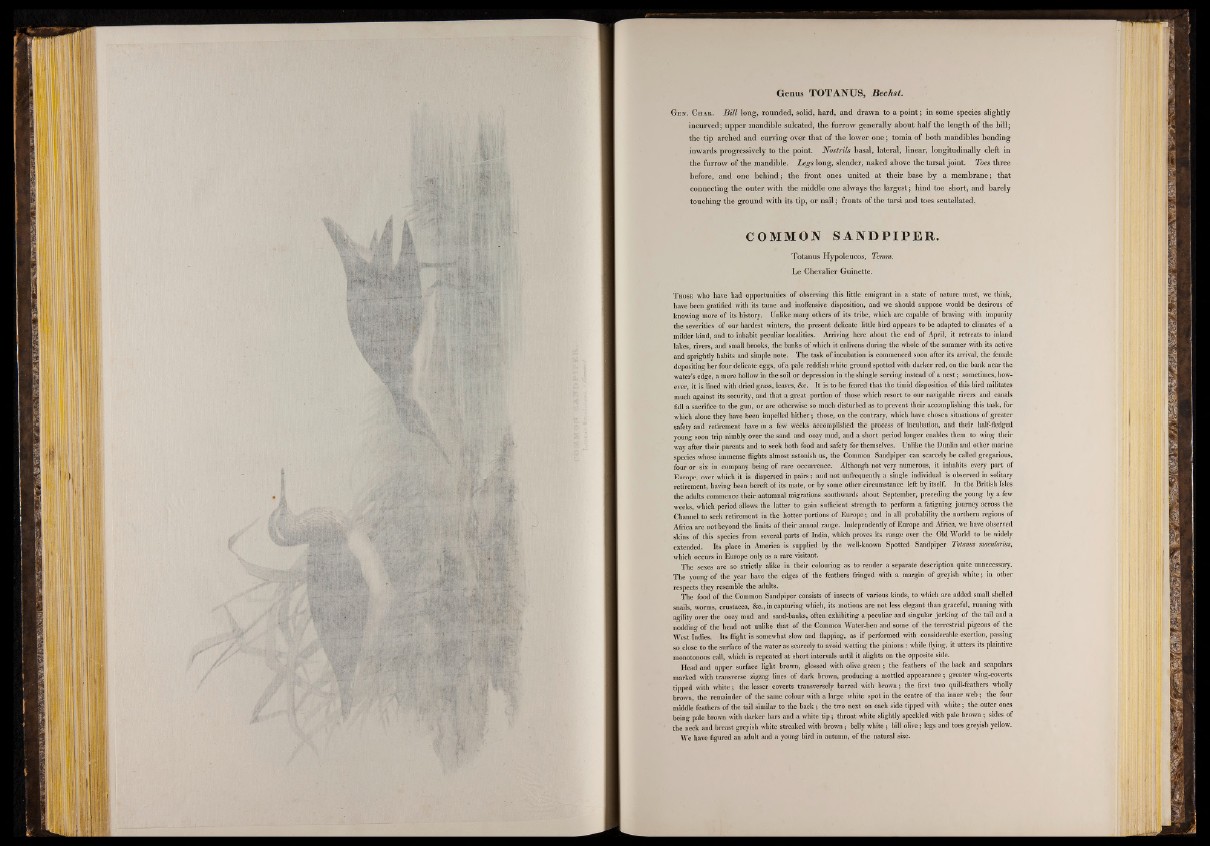
Genus TOTANUS, Bechst.
Gen. Char. B i l l long, rounded, solid, hard, and drawn to a point; in some species slightly
incurved; upper mandible sulcated, the furrow generally about half the length of the bill;
the tip arched and curving over that of the lower one; tomia of both mandibles bending
inwards progressively to the point. N o s tr ils basal, lateral, linear, longitudinally cleft in
the furrow of the mandible. L e g s long, slender, naked above the tarsal joint. Toes three
before, and one behind; the front ones united at their base by a membrane; that
connecting the outer with the middle one always the largest; hind toe short, and barely
touching the ground with its tip, or nail; fronts of the tarsi and toes scutellated.
COMMON SANDP I PE R .
To tan us H y p o leu co s, Temm.
L e C h e v a lie r Guinette.
T h o s e who have had opportunities o f observing this little emigrant in a state o f nature must, we think,
have been gratified with its tame and inoffensive disposition, and we should suppose would be desirous of
knowing more o f its history. Unlike many others o f its tribe, which are capable o f braving with impunity
the severities o f our hardest winters, the present delicate little bird appears to be adapted to climates o f a
milder kind, and to inhabit peculiar localities. Arriving here about the end o f April, it retreats to inland
lakes, rivers, and small brooks, the banks o f which it enlivens during the whole o f the summer with its active
and sprightly habits and simple note. The task o f incubation is commenced soon after its arrival, the female
depositing her four delicate eggs, o f a pale reddish white ground spotted with darker red, on the bank near the
water’s edge, a mere hollow in the soil or depression in the shingle serving instead o f a nest; sometimes, however,
it is lined with dried grass, leaves, &c. It is to be feared that the timid disposition o f this bird militates
much against its security, and that a great portion of those which resort to our navigable rivers and canals
fall a sacrifice to the gun, or are otherwise so much disturbed as to prevent their accomplishing this task, for
which alone they have been impelled hither; those, on the contrary, which have chosen situations o f greater
safety and retirement have in a few weeks accomplished the process o f incubation, and their half-fledged
young soon trip nimbly over the sand and oozy mud, and a short period longer enables them to wing their
way after their parents and to seek both food and safety for themselves. Unlike the Dunlin and other marine
species whose immense flights almost astonish us, the Common Sandpiper can scarcely be called gregarious,
four or six in company being of rare occurrence. Although not very numerous, it inhabits every part of
Europe, over which it is dispersed in pairs; and not unfrequently a single individual is observed in solitary
retirement, having been bereft of its mate, or by some other circumstance left by itself. In the British Isles
the adults commence their autumnal migrations southwards about September, preceding the young by a few
weeks, which period allows the latter to gain sufficient strength to perform a fatiguing journey across the
Channel to seek retirement in the hotter portions o f Europe; and in all probability the northern regions of
Africa are not beyond the limits o f their annual range. Independently of Europe and Africa, we have observed
skins o f this species from several parts o f India, which proves its range over the Old World to be widely
extended. Its place in America is supplied by the well-known Spotted Sandpiper Totanus macularius,
which occurs in Europe only as a rare visitant.
The sexes are so strictly alike in their colouring as to render a separate description quite unnecessary.
The young o f the year have the edges o f the feathers fringed with a margin o f greyish white; in other
respects they resemble the adults.
The food o f the Common Sandpiper consists o f insects o f various kinds, to which are added small shelled
snails, worms, crustacea, &c., in capturing which, its motions are not less elegant than graceful, running with
agility over the oozy mud and sand-banks, often exhibiting a peculiar and singular jerking o f the tail and a
nodding o f the head not unlike that o f the Common Water-hen and some o f the terrestrial pigeons o f the
West Indies. Its flight is somewhat slow and flapping, as i f performed with considerable exertion, passing
so close to the surface o f the water as scarcely to avoid wetting the pinions: while flying, it utters its plaintive
monotonous call, which is repeated at short intervals until it alights on the opposite side.
Head and upper surface light brown, glossed with olive green ; the feathers o f the back and scapulars
marked with transverse zigzag lines o f dark brown, producing a mottled appearance ; greater wing-coverts
tipped with white; the lesser coverts transversely barred with brown; the first two quill-feathers wholly
brown, the remainder o f the same colour with a large white spot in the centre o f the inner web; the four
middle feathers of the tail similar to the b a ck ; the two next on each side tipped with white; the outer ones
being pale brown with darker bars and a white t ip ; throat white slightly speckled with pale brown ; sides of
the neck and breast greyish white streaked with brown; belly white; bill olive; legs and toes greyish yellow.
We have figured an adult and a young bird in autumn, o f the natural size.